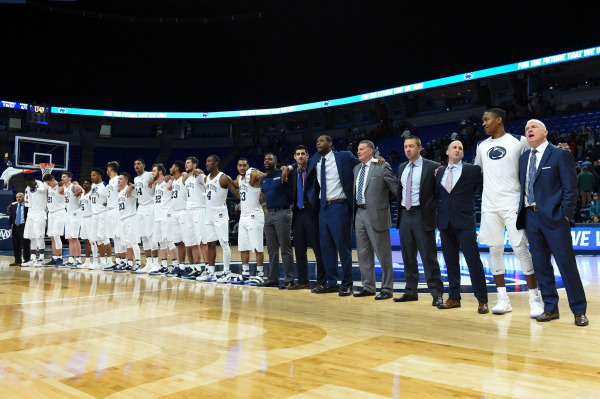
Alex Church breaks down what Penn State learned in a 1-1 start to conference play and how the Nittany Lions can improve in the Big Ten this year!
Penn State is a point away from a 2-0 start to league play and establishing itself as an early contender in the Big Ten. But as the PSU football team devastatingly learned this season, one point can make a big difference.
After picking up their first win in Iowa City since 2001, the Nittany Lions fell 64-63 at home to a Wisconsin team that has now won 10 straight against Penn State. Still, the Lions learned a lot in their first Big Ten matchups.
In an effort to hold the conference tournament at Madison Square Garden, the Big Ten bumped up the start of the event to February 28. This required conference matchups to take place earlier than usual to offset a hasty finish to the regular season.
Whether the scheduling decision will benefit the conference is a conversation for another day, but it resulted in Penn State playing two early conference games before five meetings against lesser opponents. The Lions now have a better understanding of what they need to improve, and have an opportunity to work on things before playing Maryland in early January.
The most glaring issue over the two-game stretch was a lack of bench production. The Lions survived at Iowa without a single point from their bench, but faltered when the starting five scored all but one point against the Badgers.
“We definitely need more from the bench,” coach Patrick Chambers said following the loss to Wisconsin. “Our bench needs to help us out, and you do that by earning it in practice.”
Mike Watkins got the better of All-Big-Ten player Ethan Happ with 22 points compared to Happ’s nine, but forward Julian Moore only managed one point and Virginia Tech transfer Satchel Pierce did not see the floor.
After playing all but one minute at Iowa, Tony Carr logged 38 minutes against the Badgers and made only 5-of-22 field goal attempts. Down one, Carr elected to pull up for 3 with five seconds remaining instead of driving to the hoop.
“I need to get him below 34, that’s for sure,” Chambers said of Carr’s minutes moving forward in Big Ten play. “He’s got it in him to log some major minutes, but I don’t think that’s going to be a good formula for us moving forward.”
Penn State also gained experience in end-of-game scenarios. Chambers refused to second-guess Carr’s decision to pull up from behind the arc, or his own to not take a timeout with the game on the line. The Lions had momentum, the ball in the hands of their go-to player and a favorable defensive matchup
These are moves that are easy to criticize when they fail or praise when they succeed. Both look great if the shot goes in, but the Lions gained valuable experience playing with the game on the line.
Penn State also learned that they have the ability to make a run late in games. The Nittany Lions trailed 55-41 with only 5:20 to play against Wisconsin.
Carr shot only 1-9 in the first half against the Badgers, but rallied to finish with 16 points. Despite the late deficit, Carr had the game on his hands in the closing seconds.
“We can’t just look at that last possession, because we gave up rebounds on free-throw situations, we turned the ball over, we missed layups and we missed rotations,” Chambers said. “This team can get a heck of a lot better.”
This team will get better, and the potential was on full stage in Iowa City. Mike Watkins will be a problem inside for opposing teams all year, and Lamar Stevens’ 22 points show he can deliver in conference games.
Three-point production will come and go for Penn State. It buried 12 triples at Iowa, but made only 2-14 at home against Wisconsin. Carr had an off night behind the arc against the Badgers, but has shot the ball extremely well this season.
The bench needs to come around, either from the senior Moore or newcomers Pierce and Jamari Wheeler. Those two, along with Nazeer Bostick and John Harrar will have an opportunity to show Chambers that they’re ready to contribute over the next five games.
Until then, Chambers said his team must work on its mental conditioning to ensure consistency.
“It’s the mental stamina part of the game,” he said. “It’s that ‘I do have more in me to give, I have more to give,’ and we’ve got to play hard for 40 minutes.”
